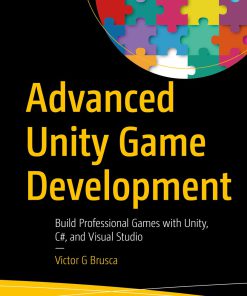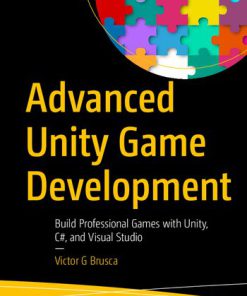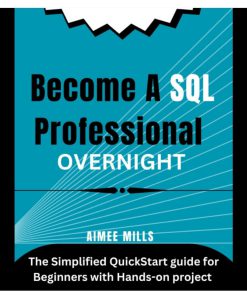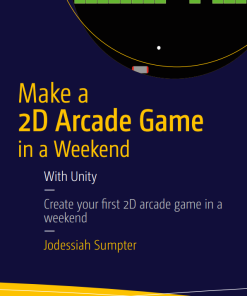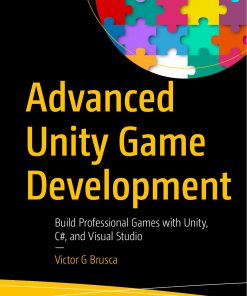Become a Unity Shaders Guru Create advanced game visuals using code and graphs 1st Edition by Mina Pecheux ISBN 1837636745 9781837636747
$50.00 Original price was: $50.00.$25.00Current price is: $25.00.
Become a Unity Shaders Guru Create advanced game visuals using code and graphs 1st Edition by Mina Pecheux – Ebook PDF Instant Download/Delivery: 1837636745 ,9781837636747
Full download Become a Unity Shaders Guru Create advanced game visuals using code and graphs 1st Edition after payment

Product details:
ISBN 10: 1837636745
ISBN 13: 9781837636747
Author: Mina Pecheux
Do you really know all the ins-and-outs of Unity shaders? It’s time to step up your Unity game and dive into the new URP render pipeline, the Shader Graph tool, and advanced shading techniques to bring out the beauty of your 2D/3D game projects! Become a Unity Shaders Guru is here to help you transition from the built-in render pipeline to the SRP pipelines and learn the latest shading tools. With it, you’ll dive deeper into Unity shaders by understanding the essential concepts through practical examples. First, you’ll discover how to create a simple shading model in the Unity built-in render pipeline, and then in the Unity URP render pipeline and Shader Graph while learning about the practical applications of both. You’ll explore common game shader techniques, ranging from interior mapping to adding neon outlines on a sprite or simulating the wobble of a fish. You’ll also learn about alternative rendering techniques, like Ray Marching. By the end of this book, you’ll have learned to create a wide variety of 2D and 3D shaders with Unity’s URP pipeline (both in HLSL code and with the Shader Graph tool), and be well-versed with some optimization tricks to make your games friendly for low-tier devices as well.
Become a Unity Shaders Guru Create advanced game visuals using code and graphs 1st Edition Table of contents:
Part 1: Creating Shaders in Unity
Chapter 1: Re-Coding a Basic Blinn-Phong Shader with Unity/CG
Technical requirements
Doing a quick study of the Blinn-Phong shading model
Using diffuse lighting for a basic render
Better integrating the object – thanks to ambient lighting
Adding some light reflections with a specular
Setting up our shader in Unity
Checking your project configuration
Creating the shader file
Implementing the diffuse lighting
Adding the ambient and specular components
Injecting the ambient lighting
Computing the specular lighting
Making a top-notch inspector!
Why should I waste time refining an editor inspector?
Faking Booleans?
Improving our glossiness display
A few additional tricks
Summary
Going further
Part 2: Stepping Up to URP and the Shader Graph
Chapter 2: The Three Unity Render Pipelines
Technical requirements
Using the built-in render pipeline
A handy but limited pipeline
The power of CommandBuffers
Stepping up with the URP render pipeline
A powerful pipeline for all creators
Making shaders and VFX with graphs
Installing the URP
Going realistic with the HDRP render pipeline
Diving deeper into the SRPs
Summary
Going further
Chapter 3: Writing Your First URP Shader
Technical requirements
Structuring a Unity HLSL shader
Having a peek at shader includes and tags
Including the URP core module
Updating our built-in variables and functions
Picking the right tags for our shader
Writing our unlit URP shader
Summary
Going further
Chapter 4: Transforming Your Shader into a Lit PBS Shader
Technical requirements
Discovering Unity PBR-related tooling
A quick overview of shader keywords and variants
Taking advantage of the built-in PBR lighting helpers
Adding the right include statements and keywords to our shader
Understanding the PBR data structures
Coding our lit PBS shader logic
Preparing our shader properties
Initializing our data structures
Setting up the vertex and fragment shader functions
Summary
Going further
Chapter 5: Discovering the Shader Graph with a Toon Shader
Technical requirements
What is the Shader Graph?
A tool for everyone…or not
Installing the Shader Graph
Discovering the Shader Graph tool
Learning the essentials of Shader Graph
An overview of the toon shader
Implementing the albedo feature
Adding alpha clipping
Handling emission
Setting up the lighting
Improving our toon shader
Adding an outline to our shader
Organizing the graph better
Summary
Going further
Part 3: Advanced Game Shaders
Chapter 6: Simulating Geometry Efficiently
Technical requirements
Using billboarding for in-game UI displays
Understanding the concept of billboarding
Implementing billboarding in Shader Graph
Faking depths and heights with parallax mapping
Reviewing the basics of parallax mapping
Fixing our squash-and-stretch issue
Creating cracked ice with dithering
Taking advantage of the built-in nodes
Creating hundreds of rooms with one cube… and interior mapping
What is interior mapping?
A quick note on cubemaps
Setting up a node-based interior mapping shader
Summary
Going further
Billboarding
Parallax mapping
Interior mapping
Chapter 7: Exploring the Unity Compute Shaders and Procedural Drawing
Technical requirements
Discovering compute shaders and compute buffers
What are compute shaders?
Using compute buffers to pass data between the CPU and the GPU
Creating and studying the structure of a compute shader
Generating a grid of randomized cubes
Writing a naive C# implementation
Examining the limitations of our CPU implementation
Optimizing the process with compute shaders
Applying a compute shader-based screen effect in URP
Preparing custom URP render assets
Integrating our compute shader in the URP
Summary
Going further
Chapter 8: The Power of Ray Marching
Technical requirements
Understanding the fundamentals of ray marching
Describing a shape with SDFs
Turning SDFs into renders with the ray marching loop
Upping the ante with basic shading
Entering a world of primitives…
Rendering a sphere with ray marching
Upgrading our procedural generation logic to handle a multi-shape render
Studying a common use case – the rendering of volumetric clouds
Using ray marching for volumetric clouds
Creating clouds in Unity
Summary
Going further
Part 4: Optimizing Your Unity Shaders
Chapter 9: Shader Compilation, Branching, and Variants
Technical requirements
Learning some Unity shader compilation tricks
Understanding Unity’s shader caching system
The magic of asynchronicity
Handling AssetBundles
Taking advantage of shader branching and shader variants
Using static branching – fast but restrictive
Turning to dynamic branching – adaptive but slow
Switching to shader variants… or not
Understanding the risks of shader variants
Exploring shader macros and platform-dependent compilation
Identifying the target platform
Checking the version of your tools
Ensuring your coordinates are oriented properly
Additional resources
Summary
Going further
Chapter 10: Optimizing Your Code, or Making Your Own Pipeline?
Technical requirements
Picking the right shading model
Exploring Unity’s URP built-in shading models
Using the URP shading models
A quick side-note for the built-in render pipeline
Optimizing your runtime performance
Float, half, or fixed?
Avoiding complex mathematical operations
Handling transparency in shaders
Creating SRP Batcher-compatible shaders
Checking that you only compute what’s needed
Having too much flexibility
Creating your own SRP
Why use a custom render pipeline?
Setting up a basic custom SRP
Summary
Going further
Shader code optimization
Custom SRPs
Part 5: The Toolbox
Chapter 11: A Little Suite of 2D Shaders
Technical requirements
Implementing color-swap, hue-shift, saturate, negate, and pixelate effects
Performing basic operations such as hue-shift, saturate, and negate
Creating a color-swap system
Pixelating a sprite dynamically
Making 2D outlines
Implementing a simple outline
Making our stroke glow
Adding animation to our outline
Having fun with overlay textures, dissolves, and holograms
Showing an overlay texture
Making a tweakable dissolve effect
Creating a hologram effect
Summary
Going further
Chapter 12: Vertex Displacement Shaders
Technical requirements
Animating fishes and butterflies
Moving fishes thanks to a vertex displacement shader
Displacing a butterfly
Creating waves with vertex displacement
Understanding the importance of mesh resolution
Setting up waves displacement
Computing our displaced normals
Browsing some extra ideas
Unity’s official vertex displacement tutorial
Alan Zucconi’s interactive map
Cyanilux’s melting candle
Summary
Going further
Chapter 13: Wireframes and Geometry Shaders
Technical requirements
Understanding the principles and limitations of geometry shaders
What are geometry shaders?
Some notable limitations of geometry shaders
Watching out for incompatibility with Apple devices
Creating a URP wireframe shader
Preparing our URP wireframe shader
Implementing the geometry stage in our shader
Making fixed-width antialiased wireframe edges
Summary
Going further
Chapter 14: Screen Effect Shaders
Technical requirements
Using fullscreen shaders in URP
The case of the built-in render pipeline
Switching our fullscreen effects over to URP
A little example – turning our render grayscale
Creating a security camera effect
Implementing the color tinting and scanlines
Improving the effect with postprocessing
Making a fullscreen box blur
What is a box blur?
Creating a box blur Sub Graph
Setting up the 2D box blur screen effect
Summary
Going further
Appendix: Some Quick Refreshers on Shaders in Unity
Rendering 3D scenes on a 2D screen
A typical 3D rendering pipeline
Using shaders in Unity
Exploring SubShader and Pass tags
Recalling the basics of z-buffering and blending modes
Culling and depth testing
Blending modes for the quick win
Reviewing textures and UV mapping
Wrapping a 2D image on a 3D shape
Broadening our definition of a texture
Using textures in a Unity shader
Summary
Index
People also search for Become a Unity Shaders Guru Create advanced game visuals using code and graphs 1st Edition:
become unity developer
shader guru
animate cc game development by pluralsight
shaders for game programmers and artists
blender guru shader
Tags: Mina Pecheux, Unity Shaders Guru, advanced game visuals, code
You may also like…
Computers - PC & Video Games
Computers - Computer Graphics & Design
Computers - Programming
Building Quality Shaders for Unity®: Using Shader Graphs and HLSL Shaders 1st Edition Daniel Ilett
Computers - Programming
Advanced Unity Game Development 1st edition by Victor Brusca ISBN 148427850X 978-1484278505
Computers - Databases
Computers - Programming
Computers - Programming
Beginning Unity Editor Scripting: Create and Publish Your Game Tools 1st Edition Benny Kok



